The origin of Motion Design studios, as told
by their founders.
By Ashley Kohler, President / Executive Producer at Awesome Inc
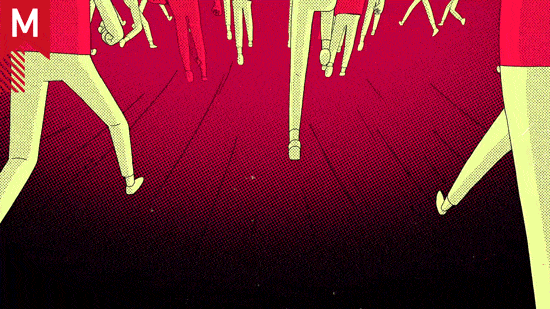
Editor’s Note: In this series, we’ll be hearing from the founders of creative studios recounting their tales of how it all began. Each studio and founder are at different stages in their journey, but whether they’re 3, 10, 15, or 20 years in the making, these candid accounts offer unique insights into what it takes to own and operate a business in the world of Motion Design.
From deciding to go it alone to growing a team, to riding the unpredictable wave of technology, to evolving through a pandemic and gearing up for the future, these studios all have inspiring stories to tell.
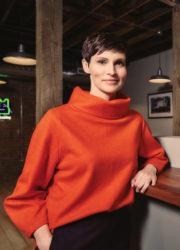
Awesome INC Founder Ashley Kohler
Things were vastly different in our industry fifteen years ago – many schools didn’t even offer Motion Design as a course of study; people weren’t using smartphones or any social media. Everything we did was focused on one screen, the television. Awesome Inc came together at the beginning of 2006, in the midst of that reality.
When Awesome Inc launched, I had been working at Cartoon Network (CN) for eight years. Being at CN was an amazing part of my journey, and I treasured my time there, but as it grew, my experience changed. It became clear that I needed to make a bold move. I was ready for a big change and an exciting challenge.
I contributed $500, and my partner at the time, Drew Tyndell, managed the same. We put the funds into a shared business account, and off we went. We already had our own computers, but we needed somewhere to operate from. For the first six months, we worked from the back bedroom in Drew’s house. These days everyone is working from home, but back then, we just weren’t set up for it. I had a 12-inch laptop literally on my lap all day, as I had no desk. Halfway through our first year, we decided to move into a real studio space, and it felt like a big step forward for our growing company.
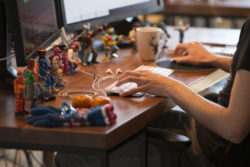
Awesome Inc Studio
At the time, we were putting our work to tape for delivery, we sent our demo reels out on DVDs, and render times seemed to take eons for each project. We made a few big purchases early on. For some reason, I was really excited to be getting a fax machine. But the biggest commitment was spending 15 thousand dollars on a used DigiBeta machine. Needless to say, both quickly became obsolete.
The iPhone came out in 2007, just a year after we opened our doors. Soon after, Facebook, YouTube, and Instagram began to take hold, and everything started to change and change fast. Content creation immediately opened to a wider group of people as the barriers to entry began to disappear. All of a sudden, people had a platform for their work, and they were able to connect and learn from others easily. As technology continued to improve, it became more economical to acquire as well.
As can be expected, we experienced the growing pains of a new business, especially during a time of such rapid development in technology. That said, our early difficulties were mainly sales-related. When you’ve been a creative or a producer by profession, and then the onus is suddenly on you have to sell – well, it’s tough. Networking at events and leaning into our existing relationships would only get us so far; at some point, we had to develop new business, which was undoubtedly a different skill set. We had to learn about sales, break into new markets and make fresh contacts, all before LinkedIn existed! Without a rep, it came down to scouring the trades, using our gut, and some good old-fashioned cold calling.
Fortunately, after years at CN, I had a good base of industry connections. I already knew the value of networking and had really worked to build relationships over the years, so I made sure we jumped in with both feet. Even still, it always felt like a challenge to find the next project and keep things going. I quickly realized that it wasn’t always about the creative – so much of it is about the service you provide and the relationships you build along the way.
Awesome Inc Studio Reel | Adult Swim – Pocket Mortys “Raid Boss” ID
I tried very hard for years to find sales representation to help, but the main response I would get was that we weren’t a great fit for them because we weren’t based in New York or Los Angeles. Even after we became more successful and had two shows on Adult Swim, we still could not attract great sales talent. I think the NY/LA thing finally went away about five years ago, but it was a real hindrance before that.
As we grew, we kept getting more organic work, and we didn’t have to “sell” as much. At a certain point, I decided that it was better to work more on PR/marketing vs. sales because I liked the idea of potential clients “finding” our work rather than someone “selling” it to them. Increasing our PR and improving our marketing has consistently helped our sales grow organically. Also, if you are a considerate vendor – communicative and reliable – your clients will remember and come back again and again. If you do amazing work, but it comes in late or over budget, it won’t matter how great it looked in the end. These concepts are so simple but really are the key to longevity in the service industry.
Awesome Inc Studio Reel | FX – What We Do in the Shadows
For more than five years our staff remained relatively small. It was nerve-wracking hiring employees in those early years because we felt a great sense of responsibility for everyone – making sure they could depend on a paycheck and their benefits – to have some stability. I still feel that same level of responsibility for our staff after all this time, but I no longer feel nervous when we’re hiring, as we’ve developed processes that allow us to manage our cash flow and make sure we have the revenue to support each member of the crew before we consider bringing anyone on.
Our first employee was an extremely talented animator named Jake Nelson Dooley that we hired pretty much right out of college. It was just the three of us for a while after that. It wasn’t until we expanded into series work in 2011 that our studio size and dynamic really grew and evolved.
Awesome Inc Studio Reel | FX Networks – Baskets Season 4 Teaser
We started the studio as a short form company – Motion Design, promos, and commercials, this type of work can make for an unpredictable revenue stream, though. The projects coming in on a month-to-month basis can make it difficult to plan, which can be stressful and, well, terrifying, especially when you are starting out. I wanted a long arc revenue stream.
In 2011, an opportunity presented itself for us to submit bids to work on the animation and composite for Aqua Teen Hunger Force and Squidbillies. We’d never worked in long-form animation, but my production background was extensive, and we’d built trust with the network.
We were doing fine up to then, but as a business owner, I saw the potential to grow. Series revenue comes in over 12-18 months, sometimes longer, depending on the schedule. So, we could take a deep breath. The margins are different between commercial work and series work – typically commercials are more profitable – but they work well together. We could borrow staff from the shows to help with commercial projects and borrow staff from the commercials to work on the shows, which kept things interesting for the artists. Eventually, we could slot more shows into our schedule and more commercials.
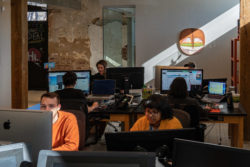
Awesome Inc Studio
From this point on, our business has continued to grow, and I feel the responsibility that comes with it. As a woman in animation, I’ve always been distinctly aware of the lack of diversity within the ranks. For that reason, along with a general belief in equity in all things, achieving diversity has been a top goal at Awesome. We realized early on that it isn’t enough just to want to hire a more diverse staff. We needed to be more proactive – so we began recruiting in different places, we sought out non-traditional candidates, and we invested in education, literally.
We frequently speak to college and high school kids, and we feel we need to be reaching back further to elementary and middle schools. There are still significant barriers to entry due to funding and resources for certain children who want to be artists, and creating diversity in our industry needs to start earlier. We want to ensure these kids (and their parents) see our work as an actual career path and not some unattainable dream. By the time kids get to college-age, it may be too late for it to evolve into a real path for them. We’ve been around for 15 years. If we had started in elementary schools back then, those kids could be working for us now. So why not start now and provide the pathways and programs that make it possible for kids today? We were set back a bit by COVID but are currently working on some things that we hope to share very soon! Without these initiatives, diversity in Motion Design and animation will never change.
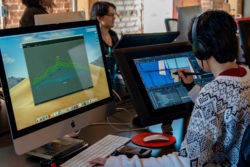
Awesome Inc Studio
Everyone’s definition of success is different. For some people, success is having a small business that pays for a certain lifestyle, and for others, it’s about world domination. For me, I just wanted to go to work and be happy every day. By that measure, we were pretty successful right out of the gate. It’s always stressful owning your own company, but once we were off the ground, I just started to trust that it would work out and never looked back.
Every life choice we make leads us somewhere, and though some choices may seem like mistakes at first, they are all part of the journey. It’s easy to be held back by fear of the unknown, but bold choices are really the key to significant results and a big change in your career and your life. Sometimes those types of choices can work out in different ways, but I try never to view bold moves as mistakes – no matter which way things go.
That said, over the past 15 years, there have been some decisions that I’ve re-examined in hindsight. For instance, I think one thing that I’d have been more thoughtful about earlier was our approach to pitching. We would have benefitted from investing more time and resources into some of the decks and treatments we sent out. It is certainly frustrating doing so much work time and time again for “free.” But, knowing what I know now – your competitors are doing that work. And the trick is to look at it as more of an investment than a frustration. I think the lesson is to plan for pitching as a part of the studio’s operating budget annually, so it is not a frustration but rather a part of doing business. You also can’t get hung up on the losses. So often, it has nothing to do with the work you’ve submitted. There are many forces at play when vendors are selected for projects, so it is always best to submit work you feel good about and then just move on and sink your teeth into the next one.
Awesome Inc Studio Reel | Fitzco – Synovus: Here is a Tap Away
Motion Design is an ever-evolving medium; we’ve made so many changes and adjustments since our inception, especially in the last ten years. We added animated series to our scope of work to increase long-arc revenue. With the advent of social media, we adapted to the changes in aspect ratios and the blurred lines between traditional content and new media content. These are challenges that have not just affected our industry but also our partners in live-action as well, and they will continue to evolve as the world comes up with new ways to communicate.
COVID, of course, came with its own set of obstacles for us to overcome, mainly tech and security related, but as time went on, we found our stride. When shooting live action wasn’t an option, clients turned to Motion Design and animation as the solution, and it helped so many people create spots and content in ways they’d not thought possible before. In the past, I’ve had sales meetings where potential clients would say, “I just can’t visualize how spots for [our product] would work without live-action.” 2020 changed a lot of minds, and I believe those are clients that will always see the value of Motion Design and animation going forward.
The good news is that there has never been a better time to be in media! For each new Motion Designer and animator that joins the workforce, there seem to be just as many new projects entering the market. With more distribution options than ever before and the seemingly insatiable appetite for content, supply has difficulty keeping up with demand. Also, with all the changes the world has experienced in recent years, there is a greater focus on diverse voices, which is so exciting to witness.
In the end, our commitment to ourselves and our clients is to remain inclusive and inquisitive, diverse and deft, and always, unapologetically, Awesome.
Studio Stories is a Motionorapher initiative created and edited by @Stuart Groves.
To tell your studio’s story, please submit your details to OOY on Motionographer.com.








